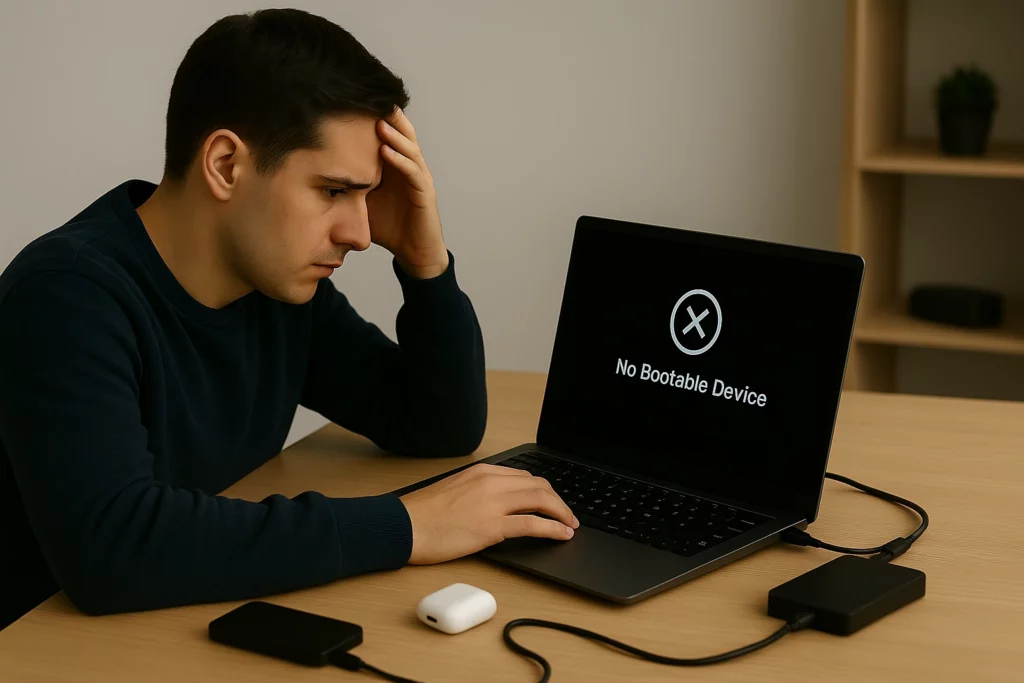How to Prevent Laptop Boot Issues: Troubleshooting Start Problems and Practical Fixes
Laptop boot issues can stop your day before it starts. Whether you’re trying to join a meeting or finish work, that frozen screen or error message can throw off your schedule fast. At Dave’s Computers in New Jersey, we’ve helped hundreds of people fix frustrating startup failures, often with simple checks that most users overlook.
This guide breaks down how to prevent laptop boot issues and offers straightforward steps to fix and prevent them.

Common Reasons Laptops Fail to Start
Boot issues can come out of nowhere. One day your laptop works fine, and the next it
refuses to power on or gets stuck on a loading screen. Often, the root cause isn’t complex
hardware failure, it’s something small and easy to fix.
Some of the most common causes of laptop boot issues include hardware conflicts and drive-related failures. As explained in our guide on how to extend laptop hard drive life, storage problems often go unnoticed until it’s too late:
-
Boot order errors in BIOS
-
Conflicts from external USB devices
-
Faulty or drained batteries
-
Damaged power adapters
-
Failing hard drives or corrupted boot sectors
Disconnect External Devices Before Starting
What You Can Do:
- Unplug all external USB devices before you start your laptop.
- Only keep essential hardware connected.
- Check your BIOS boot order (more on that below) to make sure the internal drive is listed first.
- If you still get an error, test each external device one at a time to rule out a faulty item.
Always Check the Power Source First
Troubleshooting Power Issues:
- Make sure the power cable is firmly plugged in.
- Try a different outlet.
- Inspect the charger for damage.
- Listen for startup sounds like fans or drives spinning.
- Try holding the power button for 10 seconds to force a reset.
- If the battery is removable, try starting with just the adapter—or just the battery—to
- narrow it down.
Check and Update BIOS Settings
Steps to Fix BIOS-Related Boot Problems:
Consider a BIOS Update:
Look Out for Failing Drives
Warning Signs:
- Frequent freezing at startup
- “No boot device found” messages
- Clicking sounds from the hard drive
- Blue screen errors after loading
Use Windows Recovery Options
Windows Recovery Tools:
- Startup Repair – Attempts to fix problems that prevent Windows from booting.
- System Restore – Rolls back your system to a previous working state.
- Command Prompt – Useful for advanced users to run bootrec commands.
- Reset This PC – Reinstalls Windows while keeping or removing your files.
Prevent Future Boot Problems
- Update BIOS and Windows regularly to stay protected against bugs and compatibility issues.
- Back up your data in case your drive fails.
- Keep your laptop clean—dust can lead to overheating, which damages components.
- Avoid sudden shutdowns or forcing power-offs.
- Invest in a surge protector to shield your laptop from power spikes.
Need Help? Dave’s Computers Is Here for You
- Same-day diagnostics
- Power and boot repairs
- Data recovery services
- BIOS updates and settings optimization
- Remote and in-store support

